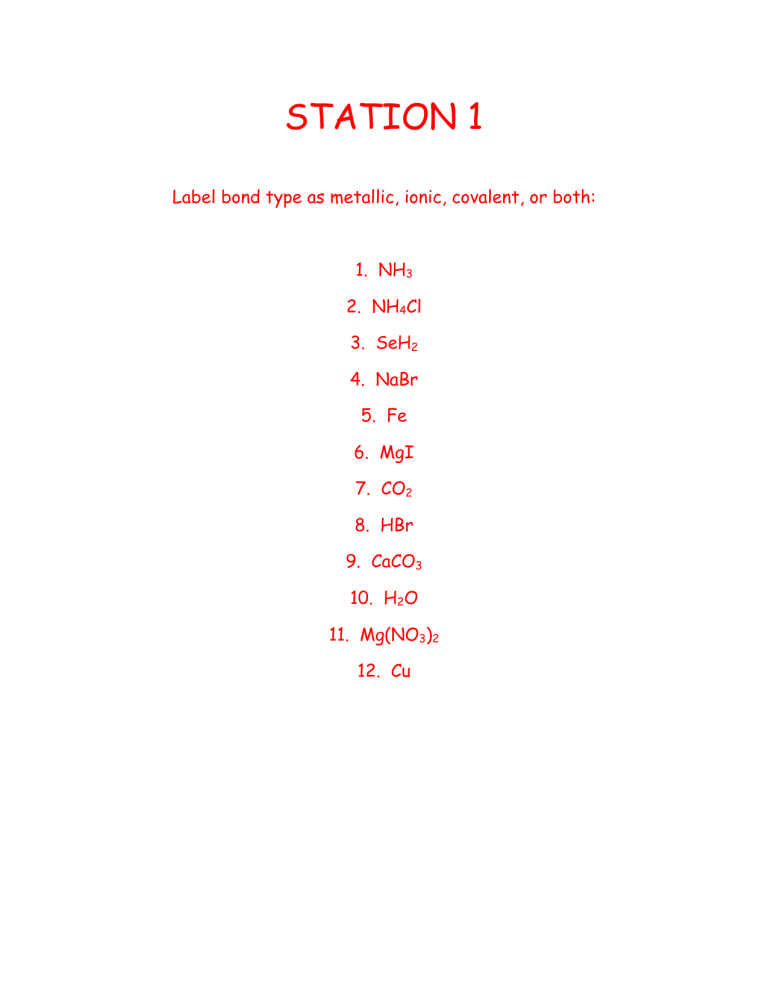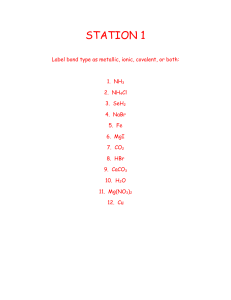
STATION 1 Label bond type as metallic, ionic, covalent, or both: 1. NH3 2. NH4Cl 3. SeH2 4. NaBr 5. Fe 6. MgI 7. CO2 8. HBr 9. CaCO3 10. H2O 11. Mg(NO3)2 12. Cu Station 2 Label bond type as metallic ionic, covalent, or both: 1. good conductor of electricity 2. usually a gas/liquid 3. high melting point 4. brittle 5. conducts electricity in the aqueous or liquid phases, only 6. dissolves in polar solvents 7. dissolves in nonpolar solvents 8. malleable/ductile 9. usually a solid 10. electrons are shared to complete valence shell 11. electrons are transferred to complete valance shell 12. electrons move freely around the atoms of the element 13. can never conduct electricity STATION 3 a. Label as metallic, ionic, or covalent b. Explain conductivity for each: when would they conduct and WHY? 1. 2. 3. STATION 4 Label the following MOLECULES (not bonds) as polar or nonpolar, and state the IMF associated with it. 1. HCl 2. H2 3. H2O 4. CO2 5. CCl4 6. CCl3H STATION 5 1. Atoms become ________________ stable since bonding ______________ energy. This is known as an ________________ process. 2. Upon bonding, the valence shell will usually have ____ electrons. One exception is hydrogen which will have ______ valence electrons after bonding to other atoms. 3. Ionic bonds_____________ electrons from the ____________ to the ________________ atom. Covalent bonds ____________ electrons between two _______________ atoms. 4. Polar bonds share electrons _________________. This is because there is a difference in ________________________. The atom with a _______________ electronegativity will pull the electrons ___________, giving it a partially _______________ charge. The less electronegative atom will then have a partially _______________ charge. STATION 6 Match the following substances to the properties described below (read the entire passage to get the most out of this station!): a. CaBr2 b. CO2 c. Cu d. MgO e. F2 1. It has the weakest of the three bond types and therefore is brittle and has a low melting point. It cannot conduct electricity no matter the phase because it can never have mobile charges. It can only occur as a solid under very high pressure. This substance is also known as a molecule. 2. This substance is a solid and has a very high melting and boiling point. It can conduct electricity in any phase since the valence electrons are free to move around the nuclei of the element’s atoms. It can be hammered into sheets (malleable) or spread into wires (ductile). 3. This substance is very hard and has a high melting point. It exists in a crystal lattice structure. It is referred to as a salt. This substance can conduct electricity, but only if it is melted or if it is dissolved in water. 4. Draw the Lewis dot structures for F2 and MgO


